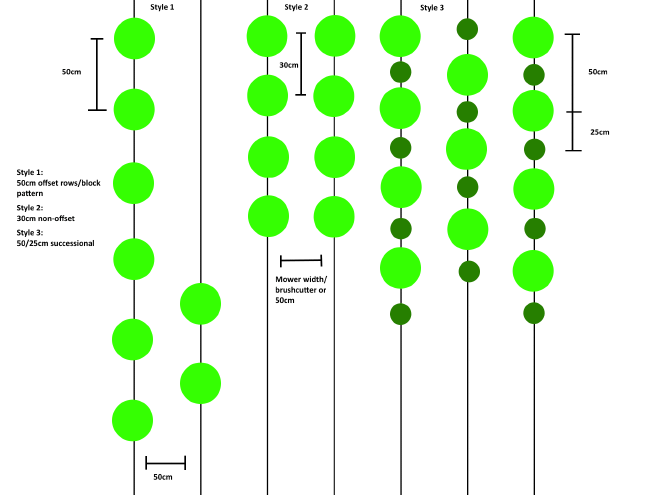Possible Nursery Planting Layouts

Planting layouts in a nursery can be varied and in any style that an owner chooses. Some are streamlined for mechanisation with row width corresponding with tyre track width, for one example. As long as you give a plant room to grow in a sunny position, each ‘mother’ clump should provide you with a significant number of slips (propagation pieces) during later division.
For more information on division, please click here.
I have illustrated 3 possible styles for simple nurseries in the above picture. Click on it to see it larger.
Style 1 is a standard 50cm x 50cm staggered offset layout. This maximises photosynthetic potential for each plant and after 12-24 months (dependent on location of nursery, nutrient, and water), one could dig and divide each row for planting projects. The advantages to this is that it is simple, each plant gets a lot of sun, and it is an efficient use of space. The disadvantage is that there are also a lot of niches for weeds to access the sun while you wait for the Vetiver Grass to get large and start self-shading/mulching the competition out. This can be sorted with supplied mulching but that is energy intensive.
Style 2 utilises closer spacing to close off weed niches sooner at the expense of some sun access for each clump. The row width can also be widened for mowing access if the nursery was placed in a grassed area. Consider row width to be just wider than the wheel track of a mower, or the width of a brushcutter blade or string. The row width could be closed to 30cm as well for greater weed shading potential at the slight expense in increased competition between each Vetiver plant.
Style 3 is an experimental style for newer growers that are hoping to increase the size or output of their nursery faster than the 12-24 month cycle that is ideal for individual clumps. It also has the advantage of maximising photosynthetic potential while each clump grows (more leaf per square metre). A 50cm offset pattern is the end goal for this style but using plants in-between at 25cm spacing that are removed/divided when they begin to compete with the 50cm-spaced plants. The smaller plants that are removed could be used to increase the size of the nursery or for other means. An example may be that at 24 months, each 50cm clump has 40 slips but in the interim, smaller plants have been removed with 10+ slips. The smaller plants could be removed at the 4-12 month mark which is dependent on growing season and competition issues with other plants. A Spring planting that has had above average temperature and rain could have interim plants removed at 4 months at a good size, giving the new slips that are divided in the Summer/Autumn months more time to grow which usually corresponds with the tropical monsoon. This should increase nursery size faster in the first year. For example; plant at 25cm centres in Spring, dig up interim plants in Summer (4+ months later), and the remaining heat of Summer/Autumn will allow the newly divided plants to establish well before Winter. If you are desperate for plants, there may be a slight increase in production initially but eventually, just dividing at 12-24 months may be the simplest way to go once your supply and nursery size is secured.
Style 4 is whatever you can come up with and if you try something new, please let me know. One possible layout for those of you with ride on mowers could be double rows at 30cm x 30cm spacing with a mower track between each double row. A lot of driptape irrigation also comes at 30cm spacing between drippers so that can also be a secondary benefit to spacing selection and efficiency.